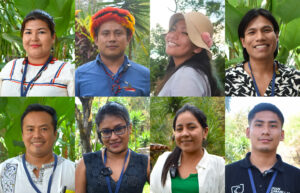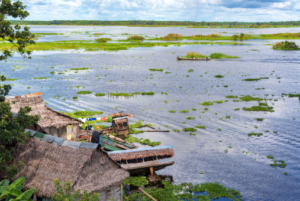Photojournalist Patrick Murayari, who is part of the kukama-kukamiria Indigenous community in Loreto, Peru, reports on pollution that has been caused by hydrocarbon extraction companies for decades.

Photojournalist Patrick Murayari, from the kukama-kukamiria Indigenous community, make visible pollution generated by hydrocarbon extraction companies in Amazon territories. (Photo credit: Salud con Lupa).
He said it’s affecting the health of Indigenous populations who have denounced the situation for years, but are not heard because they lack visibility.
“Many of my projects are based on my political decisions, my experiences. I was born in a neighborhood where the water is no longer useful for bathing or drinking. Even so, children continue to bathe there, that is our culture. That is my concern,” he told LatAm Journalism Review (LJR).
Murayari is one of eight journalists, social communicators and photographers selected as part of a new scholarship program in the Peruvian Amazon from Salud con Lupa, a digital media outlet that focuses on public health reporting.
As part of the program, Salud con Lupa also created a training program and launched the first network of Indigenous health communicators and journalists in the region.
The objective of the program, which is supported by the Canada Fund for Local Initiatives, is to strengthen coverage of the main public health challenges facing Indigenous populations who live in the area.
And the creation of the Network of Indigenous Health Communicators in the Amazon responds to the need for local journalists to tell their problems and choose which stories they want to develop, Salud con Lupa founder and director Fabiola Torres told LJR. She added that it is also a way to put the focus on health issues, which, in the Amazon, are often eclipsed by the environment or defense of the land.
The idea for the project came from a devastating public health crisis in northern Peru in July 2023.
After news broke that nine children from an Indigenous community in Loreto died after an outbreak of diarrhea, the team at digital outlet Salud con Lupa knew it had to do something.
“We heard the news because the leader of the Chapra Nation went to Lima to write up what was happening and none of the national media were reporting on it. For us it was a motivation, we decided that we had to do something more,” Torres said.
“We knew that we were reaching a group of journalists and communicators who have a lot to say but who have not had the tools to do so,” she said.
Training in the Peruvian Amazon
About 50 communicators and journalists from Loreto and Amazonas benefited from the first training program. These are two departments located in northern Peru that are crossed by the Amazon jungle, the largest tropical rainforest in the world.
The first phase of the program took place in October 2023 with a two-day training for journalists in the city of Bagua in Amazonas, and in the city of Iquitos in Loreto.

Trainings from Salud con Lupa in the Peruvian Amazon were held in Bagua, Amazonas, and Iquitos, Loreto. Around 50 Indigenous journalists and communicators from the region participated. (Photo credit: Salud con Lupa)
Due to the great distances between cities and communities in the Amazon, Torres said some of the participants had to travel two days by air, river and road to arrive.
The trainings were opportunities for participants and the Salud con Lupa team to get to know each other, and to talk about what health is and what it entails in Indigenous communities.
Some of the main topics addressed in the training program –based on the public health difficulties face by Indigenous communities in the Peruvian Amazon and the interests of journalists– are high rates of maternal mortality in Indigenous communities, lack of access to potable water and medical services, food insecurity, and impacts on health as a result of extractive activities.
“A premise of Salud con Lupa is that we were not going to teach anything to journalists from Indigenous communities, they are the ones who have the experience that we need to make visible and strengthen,” Torres said.
Among the journalists and specialists who were invited to share their knowledge and experiences, Torres highlighted the members of Ucamara radio which operates in the area; public health expert, Magaly Blas, who works with Indigenous communities; and journalist Vanessa Romo, expert in the Awajún Wampi culture.
Producing journalism in the Amazon
The second phase of the program, which is currently being developed, consists of the journalists and communicators who participated in the training applying for funding scholarships of 3,000 Peruvian soles (the equivalent of US $796). They will develop stories focused on Indigenous health and will receive editorial advice from the Salud con Lupa team.
The eight journalists, social communicators and photographers selected for this round are working on stories that will be published in February 2024, according to Torres.
Murayari, the photojournalist, said he applied for the training “to have more tools and build a network, to meet other communicators who work on these issues.”

Eight journalists and communicators from Loreto and Amazonas, Peru, who participated in the Salud con Lupa training and received scholarships to tell their stories. They are part of the Network of Indigenous Health Communicators in the Amazon. (Photo credit: Salud con Lupa)
For him, training programs for journalists such as the one offered by Salud con Lupa are important because in the Amazon territory “there are no training spaces and very few possibilities to show the work of journalists and communicators.”
He also said that the training has been very good, and highlighted that it was not journalists from Lima coming to the Amazon to “impose an idea of learning,” but rather Indigenous journalists who have been working with Indigenous peoples for 20 or 30 years who shared their tools and experiences.
In addition to Murayari, the journalists who participated in the training, received the scholarship to cover stories and are part of the network are: Mayra Macedo Mozombite, Ángela Rodríguez Cisneros, Efraín Venancino, Leunel Tomas Kiak, Entsa María Saván Sarasara, Fabiana Arrunátegui Silupu, and Juan Cabanillas Tuyas.
Press freedom on alert in the Peruvian Amazon
Torres said that press freedom in the Peruvian Amazon is in an “alert state.”
“Just when we were doing the workshops, acts of violence occurred against the communicators because they covered issues of illegal activities of miners that pollute the Santiago River [Amazonian river that crosses Ecuador and Peru]. That caused a lot of fear, they are being threatened in their territories for reporting these problem areas,” she added.

Iquitos, Perú (Foto: Canva)
Murayari said that the first challenge he faces when carrying out his journalistic work are the threats he receives daily.
“In the city [Iquitos] I have been threatened because here the Amazonian businessmen have a Western outlook: they are against Indigenous discourses and support transnational companies. When you make this problem visible with a name and surname, they begin to threaten you through their agents,” Murayari said.
The photojournalist, who specializes in reporting on Indigenous youth, said he has also received threats for working with Ticuna youth from an Indigenous community in northern Peru that live in an area plagued by drug trafficking.
Another challenge for practicing journalism in the Peruvian Amazon, according to the photojournalist, is getting from here to there. To go to some of the Indigenous communities you have to travel for days, even by plane or boat, which he said is very expensive.
Journalist Ángela Rodríguez, who also lives in Loreto and is a member of the communicator’s network, told LJR that another challenge for practicing journalism in the Amazon is “the lack of physical and digital connectivity between provinces and localities It is a great challenge when it comes to covering any topic.”
Regarding the training of Salud con Lupa, she said that it has “allowed me to know the perspectives and experiences of other colleagues and of the same representatives of Indigenous communities, some of them Indigenous communicators who from their experience have allowed me to learn other ways of communicating” Indigenous health issues.